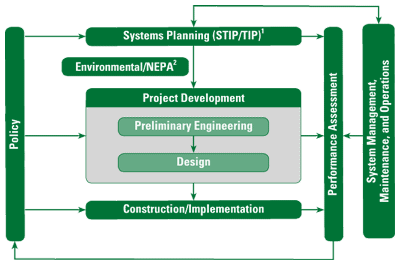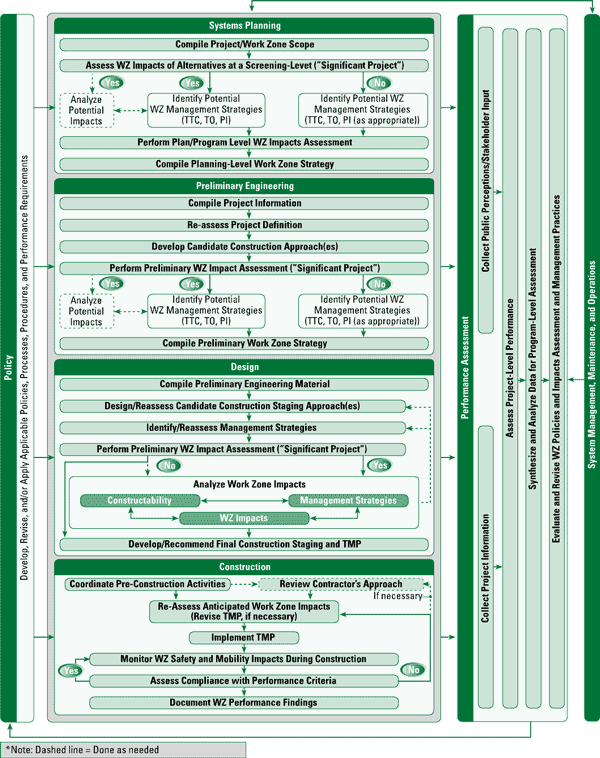2.0 Overview of the Work Zone Impacts Assessment Process
2.1 Overall Structure
Transportation agencies strive to provide for a safe, efficient, and reliable transportation system for the public. To achieve this, they perform the following two basic types of functions:
- Operate, manage, and maintain the existing transportation system.
- Identify system deficiencies and improvement needs, and develop and implement appropriate solutions that serve the identified needs.
State Departments of Transportation (DOTs) perform these two functions using a set of processes that include policy, planning, project development, construction/implementation, maintenance and operations, and performance assessment, as shown in Figure 2.1. In the figure, policy is shown as a vertical bar because an agency's policies affect all the steps of the program delivery process to some degree. Performance measurement and system management, maintenance, and operations are shown as vertical bars in Figure 2.1 because these are ongoing activities that are done continuously, rather than at one step in the program delivery process. Work zones are a necessary part of system maintenance and system improvement. Each work zone causes some level of safety and mobility impacts that can be managed by decisions made during the program delivery process.
Figure 2.1 Typical Program Delivery Process[1, 2]

2.2 Incorporating Work Zone Impacts Assessment in Program Delivery
Incorporating work zone impacts assessment in program delivery does not entail an entirely new process; rather, it involves the consideration of work zone impacts issues during pre-existing program delivery activities. Thus, the work zone impacts assessment process described in this Guide is structured to mirror the typical State DOT program delivery process.
Work zone impacts assessment may be incorporated into program delivery by:
- Implementing an overall work zone safety and mobility policy at the policy-level.
- Conducting a first-cut work zone impacts assessment at the systems planning-level.
- Conducting a preliminary project-level work zone impacts assessment during preliminary engineering.
- Conducting detailed project-level work zone impacts assessment during design.
- Managing work zone impacts during construction.
- Conducting work zone performance assessment on a regular basis.
- Incorporating work zone impacts assessment procedures in ongoing systems management, maintenance, and operations.
The level of detail and type of work zone impacts assessment varies depending upon the program delivery stage. For example, during systems planning work zone impacts assessment may involve qualitatively identifying the potential work zone impacts of a project, whereas, during design it may involve a more detailed analysis of the work zone impacts. The flowchart shown in Figure 2.2 provides an overview of the overall work zone impacts assessment process described in the remainder of this Guide.
Figure 2.2 Overall Work Zone Impacts Assessment Flow Diagram

Tables 2.1 – 2.6 provide an overview of what happens during the program delivery stages, and how work zone impacts assessment may be incorporated. Many of the key work zone impacts assessment activities are already being performed by agencies. This discussion re-emphasizes them, and incorporates the additional aspects of work zone impacts assessment and management that are advocated by the updated work zone Rule (the Rule). Subsequent chapters provide more detail on work zone impacts assessment during the individual program delivery stages.
| What happens at the policy-level? | How can work zone impacts assessment be incorporated? |
|---|---|
At the policy-level, overall policies and program priorities are established, and applied to the different program delivery stages. As shown in Figures 2.1 and 2.2, policy development and implementation is an over-arching aspect of program delivery that takes place on an ongoing basis. This includes:
|
Work zone impacts assessment starts at the policy-level by setting the tone for an overall work zone policy that supports the systematic consideration and management of work zone safety and mobility impacts. This overall work zone policy may then translate to specific policy components (i.e., vision, goals, objectives, and policy provisions) that help assess and manage work zone impacts through the respective program delivery stages. Many agencies have existing work zone policies. These policies may be updated and/or further developed as needed. In the absence of a pre-existing overall policy, a new one may have to be developed and implemented. Work zone impacts assessment may be addressed at the policy-level by:
|
| What happens during systems planning? | How can work zone impacts assessment be incorporated? |
|---|---|
Systems planning constitutes two major groups of activities, namely, "Identifying Transportation Improvement Needs," and "Developing Long-range and Short-term Transportation Plans and Programs."
|
The purpose of work zone impacts assessment during systems planning is to understand the work zone impacts of projects at the conceptual planning-level, and identify and cost potential management strategies. This will help allocate resources more effectively to projects early in the project delivery cycle and potentially avoid delays, cost over-runs and change orders in later stages. Work zone impacts assessment may be incorporated in systems planning as follows:
|
The transition from systems planning to project development may not always be distinct. Some activities may extend across both systems planning and project development. For example, environmental/NEPA analyses, and the consideration of regional and corridor impacts may extend well into the preliminary engineering phase of projects. Practitioners are encouraged to consider work zone impacts issues during these activities irrespective of the stage in which they take place.
| What happens during project development? | How can work zone impacts assessment be incorporated? |
|---|---|
Project development is where individual projects are developed and designed, and plans are developed for building the project in the field. The majority of work zone impacts assessment currently takes place during project development. The former Rule required only traffic control plans (TCPs) for projects; therefore a majority of work zone impacts mitigation is centered around developing TCPs for projects. Project development consists of two stages – Preliminary Engineering and Design.
|
Current project-level work zone impacts assessment practices may be further enhanced by systematically assessing work zone impacts through the project development stages and by looking at work zone impacts mitigation from a transportation management perspective rather than just a traffic control perspective. The updated Rule requires the development of a transportation management plan (TMP) for each project.
|
Note: In September 2004, the Federal Highway Administration (FHWA) updated the work zone regulation at 23 CFR 630 Subpart J and renamed it the Work Zone Safety and Mobility Rule (the Rule). Refer to Section 1.6 of this Guide for information on the Rule.
| What happens during construction? | How can work zone impacts assessment be incorporated? |
|---|---|
Construction/implementation is where projects are built in the field. Generally, the focus is on implementing the TCP prior to construction, maintaining traffic through the work zone, facilitating safety for motorists and workers, and monitoring and managing the work zone and the construction. |
During construction/implementation, the objective is to monitor and manage the work zone impacts of projects on an ongoing basis. This may be done by implementing the TMP, monitoring work zone impacts, and revising the TMP if necessary to improve the performance of the work zone. |
| What happens during performance assessment? | How can work zone impacts assessment be incorporated? |
|---|---|
Performance assessment is where the performance of the processes, practices, and procedures are assessed for their effectiveness, successes, and failures at the project and program levels. |
Assessing the performance of individual work zones, analyzing area-wide impacts of multiple projects (before, during, and after construction), synthesizing information to identify trends, and conducting process reviews all provide information that can be used to improve the agency's work zone processes, practices, and procedures. |
| What happens during maintenance and operations? | How can work zone impacts assessment be incorporated? |
|---|---|
Maintenance and operations encompass the ongoing activities that are typically performed by an in-house maintenance crew. They encompass both planned and emergency maintenance. Examples of typical activities include installation and maintenance of traffic signs and other roadside devices, debris removal, painting/striping, minor guardrail work, mowing operations, and minor utility work. Such activities generally require short-term and/or mobile work zones. Currently, most agencies employ typical temporary traffic control (TTC) approaches for different types of operations/maintenance work zones. These typically are based on engineering judgment and analyses, and generally focus on the safety aspects of these work zones. |
Current work zone impacts assessment and management practices for maintenance and operations may be enhanced by:
|
2.3 Work Zone Impacts Considerations
The essence of assessing and managing the work zone impacts of road construction and maintenance projects lies in:
- Safety - Maximizing the safety of road users and highway workers.
- Mobility - Maximizing mobility and accessibility on roadways.
- Constructability - Planning, designing, and building projects as effectively and efficiently as possible.
Safety, mobility, and constructability are the three critical work zone related issues that need to be addressed while planning, designing, and building road projects. Constructability can be defined as the optimum use of construction knowledge and experience in planning, design, procurement, and field operations to achieve overall project objectives. The objective of constructability is to facilitate rational bids and minimize problems during construction. Benefits of constructability include cost reduction, schedule adherence, higher productivity, enhanced quality, and more safety and convenience for the traveling public.[3] Constructability reviews are performed to facilitate the practicality of construction and minimize project delays, changes, and costs, while at the same time maximizing productivity, quality, safety, and convenience.
TIP: Constructability and value engineering may be similar in that they require reviews of project plans and designs; however, their purposes are vastly different. Value engineering provides for the necessary functions while reducing or eliminating project costs. Value engineering is normally performed during the design and/or construction phase, whereas constructability needs to be reviewed on an ongoing basis throughout project development. More information on value engineering is available on the Federal Highway Administration (FHWA) Value Engineering web site at https://www.fhwa.dot.gov/ve/index.htm.
As work zone impacts assessment is performed progressively through the various program delivery stages, the three basic issues of safety, mobility, and constructability are addressed in an iterative manner. Information from one stage feeds into the next, with the level of detail of the assessment progressively increasing from stage to stage. The objective is to achieve constructability without compromising safety and mobility. Safety, mobility, and constructability are affected by the following types of issues, including:
- Project characteristics.
- Travel and traffic characteristics.
- Corridor, network, and community issues.
- Design, procurement, and construction options.
- Work zone design and safety issues.
- TTC strategies.
- Transportation operations (TO) strategies.
- Public information (PI) strategies.
Table 2.7 provides an overview of different work zone impacts considerations for each of these issues. Additional detail on these considerations is provided throughout this document at appropriate locations.
| Project Characteristics |
|---|
|
| Travel and Traffic Characteristics |
|
| Corridor, Network, and Community Issues |
|
| Design, Procurement and Construction Options |
|
| Work Zone Design and Safety Issues |
|
| TTC Strategies |
|
| TO Strategies |
|
| PI Strategies |
|
Developing and Implementing Transportation Management Plans for Work Zones provides a focused discussion on TTC, TO, and PI strategies along with overview discussions, applicability, advantages, and disadvantages. This Guide is available at http://www.ops.fhwa.dot.gov/wz/resources/final_rule.htm (Accessed 1/18/06).
Appendix A presents an example application of how the overall work zone impacts assessment process described in this Guide can be applied to a project. The appendix discusses the work zone impacts issues faced by the project and describes the strategies used for the project to mitigate work zone impacts.
- STIP – Statewide Transportation Improvement Plan; TIP – Transportation Improvement Program
- NEPA – National Environmental Policy Act
- National Cooperative Highway Research Program (NCHRP) Report 390, Constructability Review Process for Transportation Facilities, Stuart Anderson and Deborah Fisher, National Academy Press, 1997.